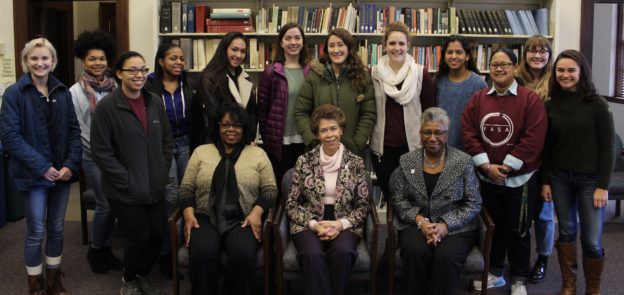In January 2017, I went from not knowing much about William & Mary’s Lemon Project to falling in love in one weekend. The Lemon Project was my colleague’s assistantship last year, and, by a stroke of fate, she needed someone to help her run a three day long intensive workshop. By the end of the weekend, I was consumed by passion for the Lemon Project’s work, love and admiration for the students who had participated, and proud of their digital exhibit on race relations in the school’s newspaper archives. I had no doubt that in the coming academic year, I wanted to become the Lemon Project assistant and run my own version of the trip. I inherited the Lemon Assistantship last year and thus facilitated my own Branch Out project this past weekend.
The Lemon Project, as I learned that weekend, was an attempt to rectify wrongs perpetrated by the College of William & Mary against African Americans during their 300 year relationship with the College. The Project was initiated by William & Mary students who felt that it was not enough to simply acknowledge the presence of slavery and Jim Crow. They advocated for the creation of a program which would research the history of African Americans while also educating the public about these issues through community engagement and student outreach.
One of the ways in which we engage with students is through the Branch Out Alternative Break program. Over the course of a three day weekend, the students learn about the African American communities whose stories, though often untold, have been a part of William & Mary’s historical narrative for centuries, and produce a final project based on their research. When they aren’t working, they participate in other related workshops, watch films, and participate in local activism. For this particular Branch Out Alternative Break, the students got to create a digital exhibit which tied in with another celebration happening on our campus. This year, William & Mary is commemorating the 50th anniversary of the first residential African American students, Lynn Briley, Karen Ely and Janet Brown Strafer. My students were fortunate enough to have the opportunity to interview these trailblazers, focusing on the themes of space and place, and created a digital exhibit on Omeka based on their responses.
My twelve students asked amazing questions, covering everything from where did they study and hang out to how did they engage in activism. Briley, Ely and Brown Strafer kept my students laughing, telling them stories about physical education class in the 60s and accidentally violating the dress code. They answered more serious questions, as well, reflecting that though they were in school during the Civil Rights Movement, Vietnam and the beginning of the Women’s Rights Movement, they needed to keep their eyes on the prize: their diplomas. They noted, for example, that if they were caught demonstrating, they would be among the first asked to leave school.
Coupled with their research on buildings around campus and in nearby Colonial Williamsburg, the students used the interview responses to create a digital exhibit called “Building a Legacy: A Sense of Place for the First Residential African American Students at William & Mary.” I was astounded at the quality of their work considering the amount of time that they had to achieve it in. They worked in small groups to write about residential, academic and social spaces that Ely, Briley and Brown Strafer encountered while at school. They peer edited their work. They came together to create a title, write an introduction and conclusion.
Though their exhibit was definitely the focal point of their experience, we also participated in other exciting workshops. The students attended lectures about the Lemon Project and how to do history of buildings, places and spaces. They watched an oral history that Ely, Briley and Brown Strafer did for the College and Hidden Figures, as a geographically comparable integration story. They even participated in a local activism project called Moral Mondays and afterwards engaged in a workshop run by HASTAC scholar Ari Weinberg on working through what activism is and can be, while also working to discover how to fight the good fight and take care of themselves.
As a teacher who strives to cater to my students’ emotional and mental well being, as well as their intellectual pursuits, I instituted two additional pieces to the project: blogging and mindfulness. Though they were already creating a digital exhibit, I wanted my students to have a space to reflect and outwardly process what they were doing, so I asked them to write three very short blog posts reflecting on each day. I chose to end each day with a mindfulness exercise because doing history can be fatiguing. It can be overwhelming. The information and the stories you uncover can affect you in ways you did not know were possible. And at the end of extremely packed days, I wanted to give them the opportunity to decompress and unwind from everything they had accomplished. Upon reflection, I still believe blogging is useful, but coupled with the bigger digital project, it might have been too much work. However, they were enthusiastic about mindfulness and suggested that some of the exercises really worked to help ground them and relax.
As a graduate student who has yet to have the opportunity to TA or teach my own class, facilitating Branch Out through the Lemon Project has been a wonderful opportunity for me to work with some of William & Mary’s finest undergraduates. They always blow me away with their willingness to engage and their intellectual curiosity. Next year is a mystery, but hopefully on Martin Luther King, Jr. Day, you will find me with a new group of amazing students, working on a new project and engaging in local activism.

